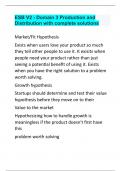Essay
Unit 1 - P1, P2, M1, D1 - The Periodic Table, Atomic Structure and Chemical Bonding
- Course
- Institution
This is my full assignment for my distinction graded Unit 1. It includes; fluency, structure, photographs, diagrams, full reference list, little to no plagiarism plus more that are not included in the singular tasks! Please keep in mind that this is my own published assignment that has been inte...
[Show more]












